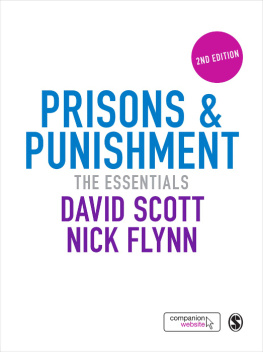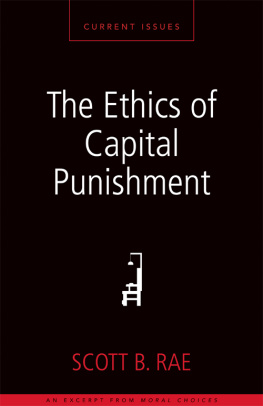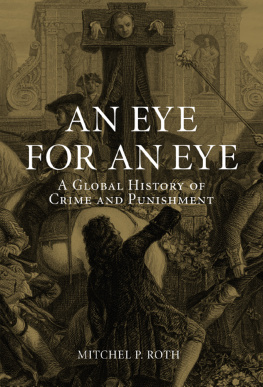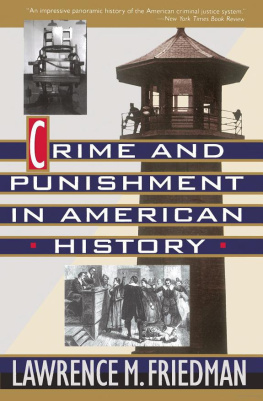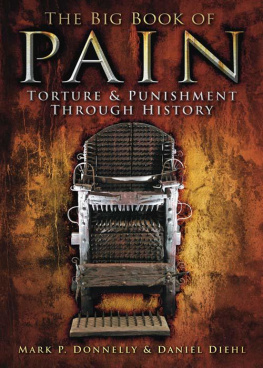CRUEL AND UNUSUAL
Cruel and Unusual
The Culture of Punishment in America
ANNE-MARIE CUSAC

Published with assistance from the Louis Stern Memorial Fund.
Portions of Chapters 9 through 12 first appeared in The Progressive.
Copyright 2009 by Anne-Marie Cusac.
All rights reserved.
This book may not be reproduced, in whole or in part, including illustrations, in any form (beyond that copying permitted by Sections 107 and 108 of the U.S. Copyright Law and except by reviewers for the public press), without written permission from the publishers.
Set in Scala and Scala Sans type by Keystone Typesetting, Inc. Printed in the United States of America.
Library of Congress Cataloging-in-Publication Data
Cusac, Anne-Marie.
Cruel and unusual : the culture of punishment in America / Anne-Marie Cusac.
p. cm.
Includes bibliographical references and index.
ISBN 978-0-300-11174-3 (cloth: alk paper)
1. PunishmentUnited StatesHistory. 2. PrisonsUnited StatesHistory. 3. Prison administrationUnited StatesHistory. 4. PrisonersUnited StatesSocial conditions. I. Title.
HV8693.C87 2009
364.60973dc22 2008042943
A catalogue record for this book is available from the British Library.
This paper meets the requirements of ANSI/NISO Z39.48-1992 (Permanence of Paper). It contains 30 percent postconsumer waste (PCW) and is certified by the Forest Stewardship Council (FSC).
10 9 8 7 6 5 4 3 2 1
For Judith Strasser, journalist and poet. Without her support and perceptive criticism, I could not have written this book.
And for Morgan, with wishes for a happy life.
Excessive bail shall not be required, nor excessive fines imposed, nor cruel and unusual punishments inflicted.
Eighth Amendment to the U.S. Constitution
ACKNOWLEDGMENTS
During my first months with the Progressive, my editor Matthew Rothschild asked me to report on a new prison technology called the stun belt. I did not want that assignment, but I accepted it because I loved my job. At the time, I, like many Americans, strongly disliked criminals. I thought the stun belt seemed to be a good idea. But the experience of reporting on the stun belt changed me into someone willing to question why our authorities punish the way they do. The story generated media attention and an Amnesty International campaign against the belt. Eventually, information from that story went to the United Nations Committee against Torture. The assignment I didnt want became the first of many articles I wrote about punishment. I thank Matthewthe driving, sharp-minded, kind editor behind ten years of my investigative journalismfrom the depths of my heart.
Nor would I have managed to write this book without Judith Strasser, poet and journalist, formerly of the Wisconsin Public Radio magazine To the Best of Our Knowledge. Thank you, Judy, for the emotional courage, support, good humor, criticisms, and intelligence you gave.
To those strong and helpful minds, I need to add many other names. Meg Schoerke read this book in its first draft and helped me to improve my work. I am grateful to my parents for their sustaining talks. Enormous thanks go out to my brother, who advised me to write this book and who wouldnt let me off the hook when I, at first, demurred. To the others connected to me by blood and by marriage, in this country and in others, my thanks for your love, support, and interest. Special thanks go to the many who on hearing of my project said they thought it important. These include the staff of the Progressive, especially Ruth Conniff, Elizabeth Di-Novella, and Amitabh Pal, and my colleagues at Roosevelt University. Those who expressed belief in this endeavor also include peers, fellow writers and reporters, and friends, whose words I have not forgotten: Dean Bakopoulos, Paul Breslin, Barbara Briggs, Allison Chaim, Robin Chapman, Anne Clauser, John Conroy, W. S. Di Piero, Barbara Ehrenreich, Susan Elbe, Jill and Freddie Feldman, Reginald Gibbons, Catherine Jagoe, Jesse Lee Kercheval, Mary Kinzie, Jim Kirby, Fred McKissack, Erin Middlewood, John Nichols, Sara Parrell, Alan Shapiro, Alison Townsend, Ron Wallace, Anne Wilder, and many more Wisconsinites, Chicagoans, neighbors, friends, and colleagues. Finally, a thank you to John Watson, whose interest in the book, consideration, and understanding of the demands of this project provided critical support during my last months of work.
I am grateful to my literary agent, Scott Mendel, who approached me with the idea of doing a book on punishment. I also thank my editors at Yale University Press, Christopher Rogers, Laura Davulis, and Margaret Otzel, who led me through a rewarding process of critique and revision. To the two anonymous reviewers who wrote with care about the manuscript, my heartfelt gratitude. Your words benefited this book tremendously.
CRUEL AND UNUSUAL
Introduction AMERICAN LIVING IN A TIME OF PUNISHMENT
MY GRANDMOTHER AND I HAD SPENT HOURS sorting through family photographs when oneof a baby in a baptismal gownsilenced her. When she didnt speak, I searched for something to say and came up with the easy observation that the baby was cute. Hes a rapist, she answered. From the moment my grandmother pronounced him rapist, I saw in the photo no tiny innocent in white lace but a guilty, frightening man. Accompanying my new vision was an odd flush of disproportion: we could look at an infant and perceive the child as evil.
This is a book about America. It is about sheriffs and television and God. It is about patriotism and national identity. It is about American culture, from television to religion to national politics. It is about the inspiration this country gives to many others. It is about how Americans punish.
Over the past thirty-five years, the form of punishment in the United States has changed enormously. Our laws are harsher now. Convicts serve longer sentences than they once did for identical offenses. As a result, our prison and jail facilities are more crowded than those in other Western democracies. The numbers can startle. The United States, with 5 percent of the Earths population, is home to nearly a quarter of its prisoners. Since 1973 the nations imprisonment rate has multiplied more than five times, leaving the United States with both the highest such rate in the world and the largest prison system. One percent of our population is
The mounting prison population appears to have little connection to the decade-long drop in violent crime in this country. Nor are most U.S. prisoners guilty of violence. According to 2002 figures, 19 percent of state felony convictions were for violent crimes, 5 percent of these being murder convictions. Nonviolent crimes involving drug possession or trafficking made up 31 percent of total state felonies. Burglary, fraud, and other economic crimes amounted to another 32 percent.
There are a few other complexities to consider about the differences between the typical American prisoner and the stereotypical one. Many U.S. inmates today are mentally ill. Others, even in our supermax facilities (designed to house the worst of the worst), have recently been children.
As the prison population has leapt, physical treatment of the inhabitants has changed. Jails and prisons now make use of control devices that would probably have been outlawed as inhumane only decades ago, including the stun belt and the restraint chair. Some of these tools can cause significant pain.
The change in the physical treatment of our domestic prisoners translated to sometimes extreme corporal treatment of alleged terrorists overseas in the years following the attack on the World Trade Center. The Bush administration has tried to enshrine in law coercive interrogations that would violate traditional interpretations of the Geneva Conventions. Abu Ghraib is perhaps the most notorious proper noun of Operation Iraqi Freedom.
Next page

